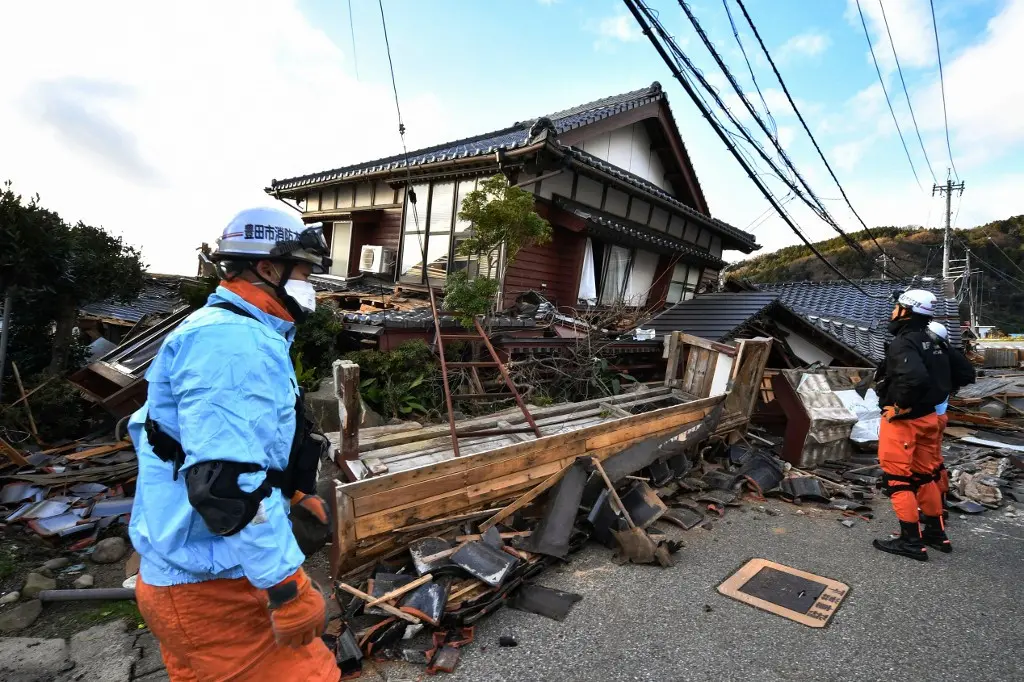Japanese rescuers searched for survivors of a New Year’s Day earthquake that left no fewer than 48 people dead and left massive damage on Tuesday against the ticking clock and strong aftershocks.
The main island of Honshu’s Ishikawa prefecture was rocked by a 7.5 magnitude earthquake that also destroyed highways, set off massive fires and generated tsunami waves that reached over a metre in height.
On the Noto Peninsula, the destruction included buildings damaged by fire, houses flattened, fishing boats sunk or washed ashore, and highways hit by landslides.
“I’m amazed the house is this broken and everyone in my family managed to come out of it unscathed,” said Akiko, standing outside her parents’ tilting home in the badly hit city of Wajima.
The way 2024 started “will be etched into my memory forever”, she told AFP after what she called the “long and violent” earthquake on Monday.
“It was such a powerful jolt,” Tsugumasa Mihara, 73, said as he queued with hundreds of others for water in the nearby town of Shika.
Local authorities put the death toll at 48, but the number was expected to rise as rescuers comb through the rubble.
“Very extensive damage has been confirmed, including numerous casualties, building collapses and fires,” Prime Minister Fumio Kishida said after a disaster response meeting.
“We have to race against time to search for and rescue victims of the disaster.”
Aerial news footage showed the terrifying scale of a fire that ripped through the old market area of Wajima, where a seven-storey commercial building also collapsed. Quake damage impaired rescue efforts to put out the blaze.
Almost 33,000 households were without power in the region, which saw temperatures touch freezing overnight, the local energy provider said. Many cities were without running water.
The US Geological Survey said the quake had a magnitude of 7.5. Japan’s meteorological agency measured it at 7.6, and said it was one of more than 210 to shake the region through Tuesday evening.
Several strong jolts were felt early Tuesday, including one measuring 5.6 that prompted national broadcaster NHK to switch to a special programme.
“Please take deep breaths,” the presenter said, reminding viewers to check for fires in their kitchens.
On Monday, waves at least 1.2 metres (four feet) high hit Wajima and a series of smaller tsunamis were reported elsewhere.
Warnings of much larger waves proved unfounded and on Tuesday, Japan lifted all tsunami warnings.
Images on social media showed cars, houses and bridges in Ishikawa wobbling violently as terrified people cowered in shops and train stations.
Houses collapsed and huge cracks appeared in roads while others were hit by landslides. Forecasters warned that rains could further loosen soil on hillsides.
A team of firefighters crawled under a collapsed commercial building in Wajima looking for survivors, television footage showed.
Monday’s quake shook apartments in the capital Tokyo about 300 kilometres (186 miles) away, where a public New Year’s Day greeting event by Emperor Naruhito was cancelled.
Overnight about 1,400 people were stuck on suspended bullet trains, including Georgia’s ambassador Teimuraz Lezhava who praised the “kindness of the station staff and the passengers around us” on social media.
Around 1,000 others were stuck in local express trains for almost 24 hours after they were halted on Monday, NHK said.
About 500 people were also stranded at Noto’s damaged airport, with access roads blocked and the runway riddled with cracks.

